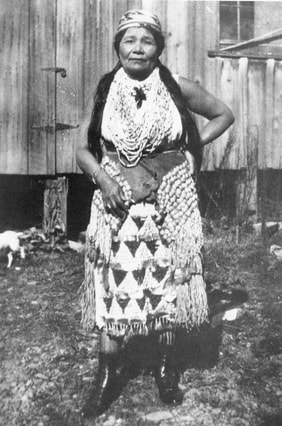Women's Ceremonial Dresses: From Long Ago to Today
Dressmaking by tribes here in the Northwest coast of California, of Hupa, Karuk, Tolowa, Wiyot and Yurok people generally shares the same form: an Apron that ties at the waist with a Skirt that wraps around from the back to be tied in front of the apron. Differences in construction, ornamentation and materials vary across time and geography. A note by anthropologist Alfred Kroeber (Handbook of the Indians of California, 1925), details dresses that were made from the late 1800’s:
|
“Women put on a buckskin apron, about a foot wide, its length slit into fringes, which were wrapped with a braid of lustrous Xerophyllum (bear grass) or strung with pine nuts. From the rear of the waist a much broader apron or skirt was brought around to meet the front piece. This rear apron was again fringed, but contained a considerable area of unslit skin.” (76)
These styles of fringe-based skirt and apron in the late 1800’s to a more rectangular cut dress after the 1930’s show a difference in structure but the spiritual intent for the dresses remains the same. These dresses were worn by women and girls for healing and world renewal ceremonies of the Brush Dance and Jump Dance respectively. Because of these ceremonial traditions being kept alive, dressmaking continues. |
Items in this exhibit represent the duality of tradition and inventiveness that shift with each other over time: meticulous beargrass braids to cut abalone shells, gathered pinenuts to found objects, and clamshells to glass beads.
Items showcased are from the Clarke and Becker collections from the Clarke Historical Museum, as well as items generous loans of newly made regalia from the community. In this case there are objects from the late 1800’s all the way to dresses made today. This tradition of adornment and ceremonial dress stretches from pre-contact for tribes in the area and we are showing a small snapshot of 150+ years of that timeline.
Items showcased are from the Clarke and Becker collections from the Clarke Historical Museum, as well as items generous loans of newly made regalia from the community. In this case there are objects from the late 1800’s all the way to dresses made today. This tradition of adornment and ceremonial dress stretches from pre-contact for tribes in the area and we are showing a small snapshot of 150+ years of that timeline.

